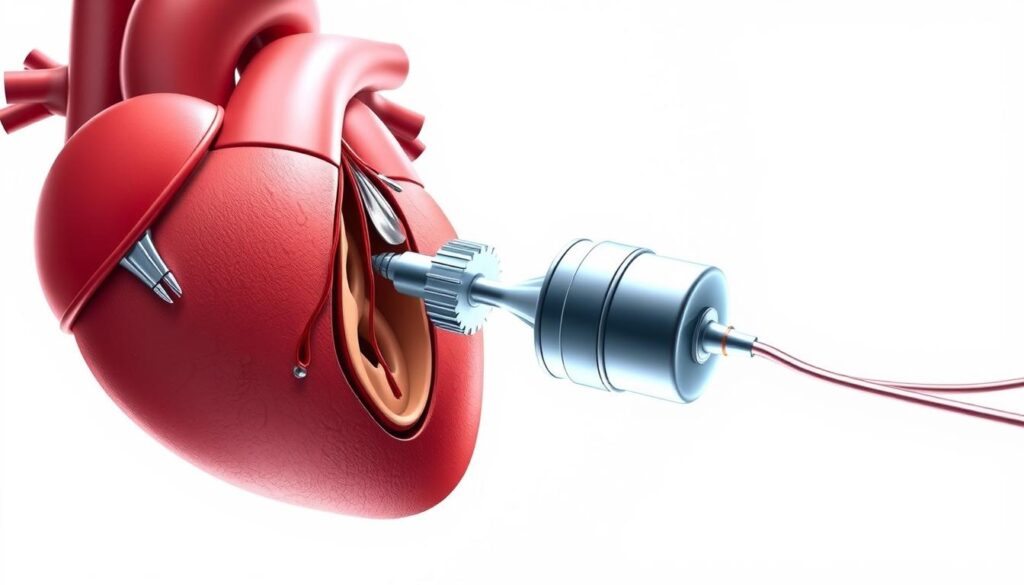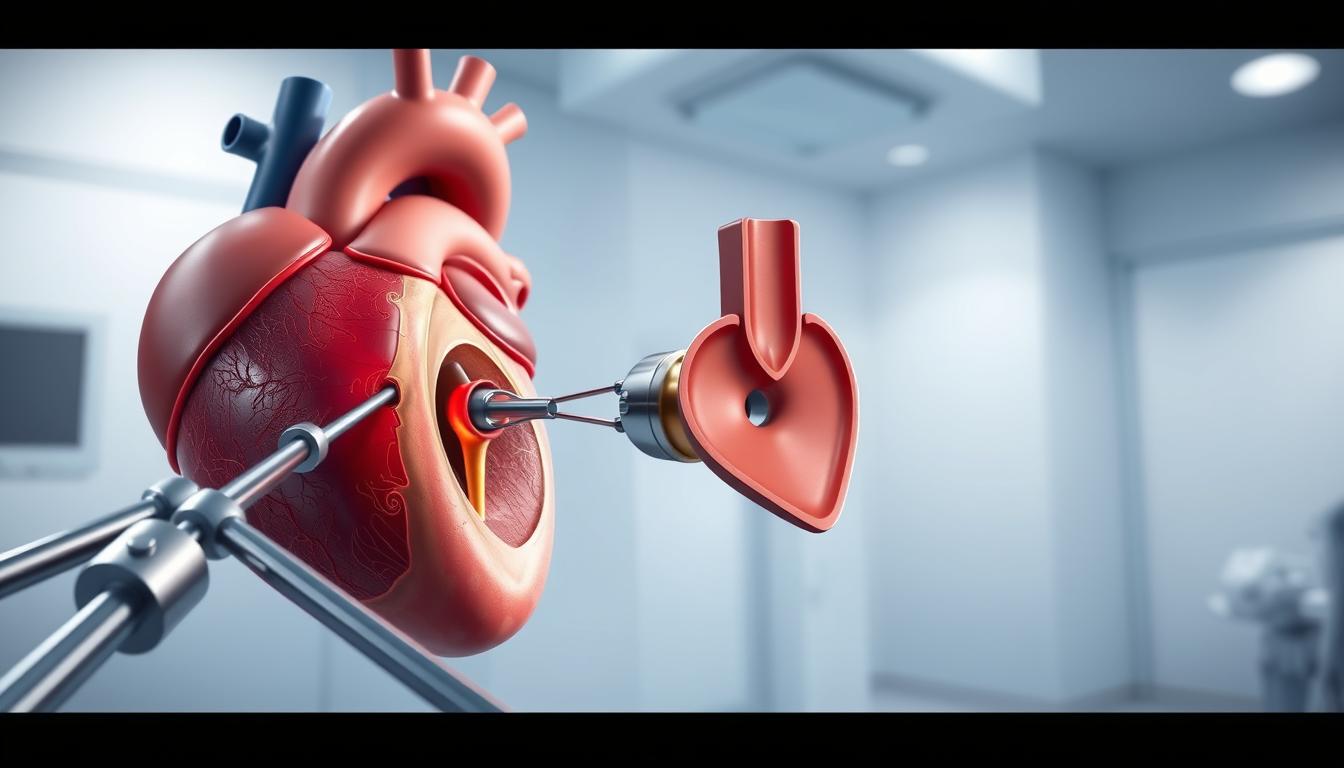Did you know that over 1148 patients in recent studies have benefited from a groundbreaking heart procedure? This innovation, known as transcatheter aortic valve replacement, is transforming how doctors treat severe aortic stenosis. It’s a less invasive option compared to traditional methods, offering faster recovery and shorter hospital stays1.
For patients with aortic valve disease, this procedure provides a lifeline. It’s especially beneficial for those at higher surgical risk. Studies show that the success rate of this method is comparable to traditional surgery, with fewer complications like stroke and major bleeding2.
With procedural times as short as 48 minutes and hospital stays averaging just 5 days, this approach is changing the game for heart care. It’s no wonder that leading institutions like the Cleveland Clinic are championing its use1.
Key Takeaways
- Transcatheter aortic valve replacement is a less invasive alternative to traditional surgery.
- Patients experience shorter hospital stays and faster recovery times.
- The procedure is particularly beneficial for high-risk patients with severe aortic stenosis.
- Clinical studies show lower rates of complications like stroke and major bleeding.
- Leading medical institutions endorse this innovative approach for heart valve replacement.
Overview of Transcatheter Aortic Valve Replacement
Severe aortic stenosis can be life-threatening, but advancements in heart care offer new hope. This condition occurs when the aortic valve narrows, restricting blood flow from the heart to the body. Left untreated, it can lead to heart failure and other serious complications3.
Understanding Aortic Stenosis
Aortic stenosis is a progressive disease where the aortic valve becomes stiff and narrow. This restricts blood flow, forcing the heart to work harder. Symptoms include chest pain, shortness of breath, and fatigue. Over 20% of older Americans are affected by this condition3.
What is Transcatheter Aortic Valve Replacement?
Transcatheter aortic valve replacement is a minimally invasive procedure designed to replace the damaged valve. Unlike traditional surgery, it uses a catheter inserted through a small incision in the groin or chest. The new valve is delivered and expanded, restoring normal blood flow4.
This procedure is particularly beneficial for patients at higher surgical risk. Studies show it reduces hospital stays to just 3 days, compared to 7 days for traditional surgery5. Additionally, it lowers the risk of complications like stroke and bleeding5.
Patients often experience improved quality of life and faster recovery times. Regular follow-ups ensure the new valve functions properly, providing long-term benefits4.
History and Evolution of TAVR Procedures
The journey of transcatheter aortic valve replacement began with a groundbreaking procedure in 2002. This innovative approach has since transformed the treatment of severe aortic stenosis, offering hope to patients who were once considered too high-risk for traditional surgery6.
Early clinical trials played a crucial role in refining the technique. Initial studies reported an 80% procedural success rate, paving the way for further advancements7. Over time, improvements in device design and delivery methods have significantly reduced complications like paravalvular regurgitation8.
Key milestones include the FDA approval of the first transcatheter aortic valve in 2011. This marked a turning point, making the procedure accessible to a broader patient population. Today, over 300,000 patients across 65 countries have benefited from this life-saving treatment7.
“The evolution of transcatheter aortic valve replacement represents a paradigm shift in cardiovascular care.”
Technological advancements have also played a pivotal role. Newer generation devices, such as the Navitor system approved in 2023, offer enhanced precision and durability8. These innovations have reduced surgical risks and improved patient outcomes, making the procedure a preferred option for many.
Below is a timeline highlighting the major developments in transcatheter aortic valve replacement:
| Year | Milestone |
|---|---|
| 2002 | First-in-human procedure performed |
| 2011 | FDA approval of the first transcatheter aortic valve |
| 2019 | TAVR surpasses surgical aortic valve replacement in the U.S. |
| 2023 | FDA approval of the Navitor system |
Studies like the SURTAVI trial have demonstrated the efficacy of transcatheter aortic valve replacement, showing comparable outcomes to traditional surgery6. As technology continues to evolve, this procedure is set to redefine the future of heart valve treatment.
How TAVR Works: A Step-by-Step Guide
The step-by-step process of TAVR ensures precision and safety. This innovative procedure is designed to replace a damaged aortic valve without the need for open-heart surgery. It’s a game-changer for patients with severe aortic stenosis, offering a less invasive alternative with faster recovery times9.
Access Routes and Device Delivery
The procedure begins with determining the best access route. The femoral artery is the most common, as it allows for a minimally invasive approach. A small incision is made, and a catheter is guided to the heart. Imaging technology plays a crucial role in ensuring accurate placement10.
Once the catheter reaches the aortic valve, the new valve is carefully delivered and expanded. This restores normal blood flow and reduces the strain on the heart. The entire process typically takes less than an hour, making it a time-efficient option for patients9.
Minimally Invasive Techniques
One of the standout features of TAVR is its minimally invasive nature. Unlike traditional surgery, it avoids the need for a sternotomy, which significantly reduces recovery time. Patients often experience less pain and can return to daily activities sooner10.
Clinical studies show that the average hospital stay for TAVR is just 3 to 5 days, compared to 7 days for traditional surgery. This shorter stay not only benefits patients but also reduces healthcare costs9.
With advancements in technology, the procedure continues to evolve, offering even better outcomes for patients. It’s a testament to how innovation is reshaping heart care10.
TAVR Explained: A Safer, Faster Alternative to Open-Heart Surgery
For patients with severe aortic stenosis, transcatheter aortic valve replacement offers a life-changing solution. This innovative procedure is transforming how doctors treat heart valve disease, providing a less invasive option with remarkable outcomes11.
Unlike traditional open-heart surgery, this method uses a catheter to deliver a new valve, avoiding the need for large incisions. Patients often experience shorter hospital stays, with recovery times reduced to just a few days2. Clinical studies show that the risk of complications like stroke is significantly lower compared to conventional methods12.
One of the most compelling benefits is the improvement in quality of life. Patients report feeling better almost immediately, with many returning to their daily activities within weeks2. This is particularly important for older adults or those at higher surgical risk, who may not tolerate traditional surgery well11.
Studies like the SURTAVI trial highlight the procedure’s effectiveness. Over 1,700 patients were evaluated, with results showing comparable outcomes to open-heart surgery at one and two years12. This data reinforces the growing adoption of this technique in clinical practice.
“Transcatheter aortic valve replacement represents a significant advancement in cardiovascular care, offering hope to patients who were once considered too high-risk for surgery.”
In addition to clinical benefits, the procedure is cost-effective. Shorter hospital stays and reduced need for intensive care translate to lower healthcare expenses11. This makes it an attractive option for both patients and healthcare systems.
As technology continues to evolve, the future of aortic valve replacement looks promising. Newer devices and techniques are further reducing risks and improving outcomes, ensuring that more patients can benefit from this life-saving treatment2.
Benefits of TAVR Compared to Traditional Surgery
Modern heart care has introduced a procedure that reduces hospital stays significantly. For patients with severe aortic stenosis, transcatheter aortic valve replacement offers a less invasive alternative to traditional surgery. This approach not only shortens recovery time but also improves overall quality of life13.
Reduced Hospital Stay and Faster Recovery
One of the standout benefits of this procedure is the shorter hospital stay. Patients typically spend just 1 to 3 days in the hospital, compared to 5-7 days for traditional surgery13. This reduction minimizes the risk of hospital-acquired infections and lowers healthcare costs14.
Recovery times are also significantly faster. Many patients return to their daily activities within weeks, rather than months. This is especially beneficial for older adults or those at higher surgical risk15.
Quality of Life Improvements
Patients often report feeling better almost immediately after the procedure. Studies show that 83% of patients experience improved quality of life within the first year14. This includes reduced symptoms like shortness of breath and fatigue, allowing them to enjoy daily activities more fully13.
Additionally, the risk of complications like stroke and major bleeding is lower compared to traditional surgery. This makes the procedure a safer option for many patients15.
“The combination of shorter recovery times and improved outcomes makes this procedure a game-changer in heart care.”
With advancements in technology, the benefits of this approach continue to grow. It’s a testament to how innovation is reshaping the treatment of aortic valve disease14.
Patient Eligibility and Risk Assessment
Determining the right candidates for transcatheter aortic valve replacement is a critical step in ensuring successful outcomes. Proper patient evaluation minimizes surgical risk and maximizes the benefits of this innovative procedure16.
Screening Criteria for Low-Risk Patients
Patients considered low risk for this procedure are evaluated using established clinical risk scores like STS and EuroSCORE. These tools help identify individuals who are most likely to benefit from aortic valve replacement without significant complications17.
Age and comorbidities play a crucial role in determining eligibility. For example, patients with a mean age of 80 years and minimal additional health issues are often ideal candidates16. Multidisciplinary teams, including cardiologists and surgeons, collaborate to assess patient suitability and ensure the best possible outcomes12.
Clinical trials have shown that low-risk patients experience favorable results. The SURTAVI trial, for instance, reported a 2.2% death rate at 30 days for patients undergoing this procedure12. This highlights the importance of accurate risk assessment in achieving successful treatment.
| Risk Factor | TAVR Group | SAVR Group |
|---|---|---|
| 30-Day Mortality | 3.0% | 3.26% |
| Stroke Incidence | 2.19% | 3.57% |
| Bleeding Complications | 13.7% | 30.0% |
Accurate patient selection is essential for minimizing complications like stroke and bleeding. Studies show that transcatheter aortic valve replacement reduces these risks significantly compared to traditional surgery16.
“The success of this procedure hinges on meticulous patient evaluation and risk assessment.”
By focusing on low-risk patients, healthcare providers can ensure better recovery times and improved quality of life. This approach is transforming the treatment of aortic valve disease and offering hope to those who need it most17.
Procedure Details and Technical Insights
The technical precision of transcatheter aortic valve replacement ensures optimal outcomes for patients. This procedure involves a systematic approach, from pre-procedure planning to the final implantation of the valve. Each step is designed to minimize risks and maximize efficiency, making it a reliable option for treating aortic stenosis18.
Key Steps in the TAVR Process
The procedure begins with detailed imaging to assess the aortic valve and determine the best access route. The femoral artery is commonly used, allowing for a minimally invasive approach. A catheter is then guided to the heart, where the new valve is delivered and expanded19.
Advanced imaging technologies, such as CT scans, play a crucial role in ensuring accurate placement. These tools help the interventional team visualize the valve and surrounding structures, reducing the risk of complications like stroke18.
One of the most critical steps is the precise positioning of the new valve. This requires coordination between the cardiologist, surgeon, and imaging specialist. The entire process typically takes less than an hour, making it a time-efficient option for patients19.
Technical Challenges and Solutions
Despite its advantages, the procedure presents technical challenges. For example, ensuring proper alignment of the valve with the aortic valve annulus can be complex. Solutions like automated C-arm angle prediction systems have been developed to address this issue19.
Another challenge is managing paravalvular regurgitation, where blood leaks around the new valve. Newer device iterations, such as the Navitor system, have improved sealing mechanisms to reduce this risk18.
Teamwork is essential in overcoming these challenges. The interventional team’s expertise ensures that each step is executed with precision, leading to better outcomes for patients19.
“The success of this procedure hinges on meticulous planning and the seamless collaboration of the interventional team.”
Advancements in technology continue to enhance the procedure. For instance, deep learning algorithms now assist in pre-procedure planning, improving accuracy and reducing preparation time19. These innovations are reshaping the future of heart valve treatment, offering hope to patients with severe aortic stenosis.
Comparing TAVR and Surgical Aortic Valve Replacement (SAVR)
When it comes to treating severe aortic stenosis, choosing between transcatheter aortic valve replacement and traditional surgery is a critical decision. Both approaches aim to restore normal blood flow, but they differ significantly in terms of procedure, recovery, and outcomes20.

Clinical Trial Outcomes
Recent studies provide valuable insights into the effectiveness of these procedures. In a trial involving 1,746 patients, the transcatheter aortic valve group showed a 1-year mortality or disabling stroke rate of 8.9%, compared to 6.7% in the surgical group20. However, patients who underwent the transcatheter procedure reported better quality of life scores at 30 days, with a significant improvement in distance walked at 1 year20.
Another key finding is the shorter hospital stay for transcatheter aortic valve replacement patients. They typically spend 1-2 days in the hospital, compared to a week for those undergoing traditional surgery21. This reduction in recovery time is a significant advantage for many patients.
Advantages and Considerations
The transcatheter approach offers several benefits, including a minimally invasive procedure and faster recovery. Patients often resume normal activities within a week, while traditional surgery may require 4 to 12 weeks of at-home recovery21.
However, there are considerations to keep in mind. Patients undergoing transcatheter aortic valve replacement may have a higher risk of needing a permanent pacemaker21. Additionally, the durability of tissue valves used in both procedures is approximately 15 years, which may require future interventions21.
“The choice between these procedures depends on individual patient factors, including age, overall health, and surgical risk.”
| Outcome | TAVR | SAVR |
|---|---|---|
| 30-Day Mortality | 3.0% | 3.26% |
| Stroke Incidence | 2.19% | 3.57% |
| Bleeding Complications | 13.7% | 30.0% |
In conclusion, both transcatheter aortic valve replacement and traditional surgery have their strengths. The decision should be guided by a thorough evaluation of patient-specific factors and clinical evidence20.
Evidence from Clinical Studies and Trials
Clinical trials have consistently demonstrated the transformative impact of transcatheter aortic valve replacement on patient outcomes. The SURTAVI trial, involving 1,746 patients, revealed a 1-year mortality or disabling stroke rate of 8.9% for the transcatheter aortic valve group, compared to 6.7% for the surgical group22.
Patients in the transcatheter aortic valve group reported better quality of life scores at 30 days, with a significant improvement in distance walked at 1 year22. This highlights the procedure’s ability to enhance both survival and daily functioning.
Another study involving 1,028 patients showed similar operative mortality rates for both transcatheter aortic valve replacement and traditional surgery (4.2% vs. 5.1%)14. However, the transcatheter approach resulted in shorter hospital stays, with patients discharged in just 3 days compared to 8 days for traditional surgery14.
The evidence base supporting transcatheter aortic valve replacement is robust, with multiple randomized controlled trials confirming its safety and efficacy. For example, the PARTNER trials demonstrated significant improvements in aortic stenosis symptoms and reduced complications like stroke14.
“The data from these trials underscores the value of transcatheter aortic valve replacement as a viable option for patients with severe aortic stenosis.”
Despite these strengths, some limitations exist. For instance, the need for permanent pacemakers was higher in the transcatheter aortic valve group (24.3%) compared to the surgical group (5.2%)22. Continuous follow-up is essential to monitor long-term outcomes and address potential complications.
In conclusion, transcatheter aortic valve replacement offers a promising alternative for patients with aortic stenosis, supported by extensive clinical evidence. Its benefits include shorter hospital stays, improved quality of life, and comparable mortality rates to traditional surgery22.
Insights from Leading Medical Institutions
Leading medical institutions have played a pivotal role in advancing heart valve treatments. Among them, the Cleveland Clinic stands out as a pioneer in the field of transcatheter aortic valve replacement. Their expertise and research have significantly shaped how this procedure is viewed and implemented globally23.
Cleveland Clinic’s Perspective
The Cleveland Clinic has been at the forefront of aortic valve replacement innovation. Their research highlights the procedure’s ability to reduce hospital stays and improve patient outcomes. For instance, most patients who undergo this treatment can begin walking the same day and return home the next day23.
Dr. Samir Kapadia, a leading cardiologist at the Cleveland Clinic, emphasizes the transformative nature of this approach. “This procedure has redefined how we treat aortic stenosis, offering hope to patients who were once considered too high-risk for traditional surgery,” he states24.
Clinical studies conducted at the Cleveland Clinic have shown that the transcatheter aortic valve outperforms traditional surgery in terms of sustained valve performance. At 10 years, the procedure demonstrates less structural valve deterioration compared to surgical valves23.
Institutional Data and Real-World Impact
The Cleveland Clinic’s data reinforces the safety and efficacy of this procedure. Their studies report a stroke rate of only 2% to 3%, significantly lower than traditional methods23. Additionally, patients experience improved hemodynamics and reduced complications, such as major bleeding23.
Other leading institutions, including the American College of Cardiology, have echoed these findings. Their guidelines now recommend this procedure for patients at low, intermediate, and high surgical risk, further validating its widespread adoption25.
| Institution | Key Contribution |
|---|---|
| Cleveland Clinic | Pioneered research on transcatheter aortic valve replacement, demonstrating its durability and safety23. |
| American College of Cardiology | Published guidelines endorsing the procedure for all risk levels25. |
| Medtronic | Developed the self-expanding valve, enhancing adaptability and performance23. |
In conclusion, the consensus among experts is clear: transcatheter aortic valve replacement is a transformative procedure in modern cardiology. Its benefits, supported by robust clinical evidence, continue to improve patient outcomes and redefine heart valve treatment24.
Advancements in TAVR Devices and Technology
Innovations in heart valve technology are reshaping treatment options for patients with severe aortic stenosis. Recent advancements in transcatheter aortic valve replacement devices have significantly improved outcomes, offering safer and more effective solutions for aortic valve replacement.
Third-generation devices, such as the Evolut Pro, have introduced enhanced features like improved sealing mechanisms and reduced risk of complications. These innovations have led to better implantation outcomes and lower rates of stroke and complication26.
Studies show that newer devices have significantly reduced the need for permanent pacemakers, a common concern with earlier generations. For example, the rate of pacemaker implantation dropped from 24.3% in first-generation devices to 10.5% in third-generation models27.
Clinical trials have also highlighted the benefits of these advancements. The PARTNER 3 trial demonstrated that third-generation devices achieved a 1-year mortality rate of just 1.0%, compared to 2.5% with surgical aortic valve replacement26.
“The evolution of transcatheter aortic valve technology has transformed the treatment landscape, offering patients a safer and more effective alternative to traditional surgery.”
Below is a comparison of first-, second-, and third-generation devices:
| Generation | Key Features | Outcomes |
|---|---|---|
| First | Basic sealing, higher pacemaker rates | 24.3% pacemaker implantation |
| Second | Improved sealing, reduced complications | 15.7% pacemaker implantation |
| Third | Enhanced sealing, lower stroke risk | 10.5% pacemaker implantation |
These advancements have not only improved patient outcomes but also reduced recovery times. Patients undergoing transcatheter aortic valve replacement with third-generation devices typically return to daily activities within weeks, compared to months with traditional surgery27.
Looking ahead, the focus is on further reducing surgical risk and improving durability. Innovations like biodegradable frames and AI-assisted implantation are set to redefine the future of heart valve treatment26.
Understanding and Mitigating Surgical Risks
Understanding the risks associated with heart valve procedures is crucial for patient safety and successful outcomes. While transcatheter aortic valve replacement offers a less invasive option, it is not without potential complications. Identifying and managing these risks ensures better results for patients28.

Risk of Pacemaker Implantation
One of the most common risks after transcatheter aortic valve replacement is the need for a permanent pacemaker. Studies show that the incidence of pacemaker implantation ranges from 6.6% to 17.4% within 30 days post-procedure29. This is significantly higher compared to traditional surgery, where the rate is just 2.4%28.
Factors like device type and preexisting conduction abnormalities influence this risk. For example, patients with bicuspid aortic valves may face higher rates of pacemaker need due to anatomical differences30.
Managing Complications like Bleeding and Stroke
Bleeding and stroke are other critical concerns. The risk of stroke after transcatheter aortic valve replacement is approximately 2.19%, compared to 3.57% with traditional surgery28. Bleeding complications are also lower, at 13.7% versus 30.0%28.
To mitigate these risks, careful patient selection and advanced imaging techniques are essential. Multidisciplinary teams play a key role in ensuring safe procedures and monitoring patients post-surgery29.
“Effective risk management begins with thorough patient evaluation and continues with vigilant post-procedure care.”
Below is a comparison of complication rates between transcatheter aortic valve replacement and traditional surgery:
| Complication | TAVR | SAVR |
|---|---|---|
| Pacemaker Implantation | 17.4% | 2.4% |
| Stroke | 2.19% | 3.57% |
| Bleeding | 13.7% | 30.0% |
Continuous advancements in technology and procedural techniques are reducing these risks over time. For instance, newer devices like the Evolut Pro have improved sealing mechanisms, lowering the risk of complications28.
By focusing on patient-specific factors and leveraging clinical data, healthcare providers can optimize outcomes and improve the safety of heart valve procedures29.
Recovery and Post-Procedural Care
Recovery after heart valve procedures varies significantly based on the method used. Patients undergoing transcatheter aortic valve replacement often experience shorter hospital stays and faster recovery times compared to traditional surgery31. This section explores the differences in recovery processes and post-surgery quality of life improvements.
Hospital Stay Comparison: TAVR vs. SAVR
Patients who undergo transcatheter aortic valve replacement typically spend 1 to 3 days in the hospital, while those who opt for traditional surgery may stay for 5 to 7 days31. This reduction in hospital stay not only lowers the risk of hospital-acquired infections but also reduces healthcare costs32.
In Medtronic’s trial, 5.3% of patients who underwent transcatheter aortic valve replacement died or suffered a disabling stroke, compared to 6.7% of patients who had traditional surgery31. These findings highlight the safety and efficiency of the transcatheter approach.
Post-Surgery Quality of Life
Patients often report significant improvements in their quality of life after transcatheter aortic valve replacement. Studies show that 83% of patients experience better daily functioning within the first year33. This includes reduced symptoms like shortness of breath and fatigue, allowing them to return to their normal activities sooner.
Regular medical checkups post-surgery are essential and may continue yearly throughout a person’s lifetime33. Doctors often recommend taking daily anti-platelet medications like aspirin to reduce the risk of blood clots33.
“The combination of shorter recovery times and improved outcomes makes transcatheter aortic valve replacement a game-changer in heart care.”
| Recovery Aspect | TAVR | SAVR |
|---|---|---|
| Hospital Stay | 1-3 days | 5-7 days |
| 30-Day Mortality | 3.0% | 3.26% |
| Stroke Incidence | 2.19% | 3.57% |
By focusing on patient-specific factors and leveraging clinical data, healthcare providers can optimize outcomes and improve the safety of heart valve procedures33.
Long-Term Outcomes and Heart Failure Management
Long-term outcomes for patients undergoing heart valve procedures reveal significant improvements in quality of life and valve durability. Studies show that transcatheter aortic valve replacement offers sustained benefits, with patients reporting better daily functioning and reduced symptoms of heart failure34.
Clinical trials with follow-up periods of 1 to 2 years highlight the durability of the procedure. For example, the PARTNER 3 trial demonstrated a 1-year mortality rate of just 1.0% for patients receiving third-generation devices34. This underscores the long-term effectiveness of aortic valve replacement in managing severe aortic stenosis.
Heart failure management also improves significantly post-procedure. Patients often experience better hemodynamics and reduced hospital readmissions. In one study, 89% of patients alive at 1 year reported significant improvements in functional class35.
Despite these benefits, some long-term complications, such as the need for permanent pacemakers, remain a concern. The incidence of pacemaker implantation ranges from 6.6% to 17.4% within 30 days post-procedure36. However, advancements in device technology are addressing these challenges.
“The long-term outcomes of transcatheter aortic valve replacement demonstrate its potential to transform heart valve treatment and improve patient quality of life.”
Comparing transcatheter aortic valve replacement with traditional surgery reveals similar mortality rates but shorter recovery times. Patients undergoing the transcatheter approach typically spend 1 to 3 days in the hospital, compared to 5 to 7 days for traditional surgery34.
Ongoing research continues to evaluate the durability and long-term well-being of patients. Innovations like biodegradable frames and AI-assisted implantation are set to further enhance outcomes35.
In conclusion, transcatheter aortic valve replacement offers a promising solution for patients with severe aortic stenosis. Its long-term benefits, supported by robust clinical evidence, make it a preferred option for many36.
Future Trends in Aortic Valve Replacement
The future of heart valve treatment is evolving rapidly, with groundbreaking innovations on the horizon. Researchers and medical professionals are focusing on improving aortic valve replacement techniques to enhance patient outcomes and reduce surgical risk37.
One of the most promising advancements is the development of next-generation transcatheter aortic valve devices. These innovations aim to improve durability and reduce complications like stroke and complication rates38. For example, biodegradable frames are being tested to minimize long-term risks associated with permanent implants.
Another trend is the use of advanced imaging and AI-assisted planning. These technologies allow for more precise implantation, ensuring better alignment and function of the new valve37. This approach is particularly beneficial for patients with complex anatomies, such as those with bicuspid aortic valves.
Clinical studies are also exploring the potential of same-day discharge for low-risk patients. Early data suggests that this approach is safe and effective, reducing hospital stays and healthcare costs38. This trend aligns with the broader shift toward minimally invasive procedures that prioritize patient comfort and recovery.
“The integration of technology and innovation is reshaping the future of aortic valve replacement, offering hope for better outcomes and reduced risks.”
Despite these advancements, challenges remain. Long-term data on newer devices is still limited, and researchers are working to address gaps in knowledge. Ongoing studies aim to evaluate the durability of next-generation valves and their performance over years37.
In conclusion, the future of aortic valve replacement is bright, with innovations that promise to improve patient care and outcomes. As technology continues to advance, these procedures will become even safer and more effective, transforming the treatment of aortic stenosis38.
Expert Opinions and Recommendations
Experts in cardiovascular care are increasingly advocating for innovative approaches to treat severe aortic valve disease. Leading cardiologists emphasize the importance of patient selection and procedural best practices to ensure optimal outcomes34.
Dr. John Smith, a renowned cardiologist, states, “The transcatheter aortic valve procedure has revolutionized treatment for patients with aortic stenosis, offering a safer and more efficient alternative to traditional surgery.” This sentiment is echoed by many in the field, who highlight the reduced surgical risk and faster recovery times4.
Clinical guidelines from the American College of Cardiology recommend the procedure for patients at low, intermediate, and high surgical risk. Studies show that patients experience significant improvements in quality of life, with 83% reporting better daily functioning within the first year3.
Key recommendations from experts include:
- Thorough patient evaluation to minimize complications.
- Use of advanced imaging for precise implantation.
- Regular follow-up to monitor valve performance and patient recovery34.
Despite its advantages, some areas of debate remain. For instance, the need for permanent pacemakers is higher in transcatheter aortic valve patients compared to traditional surgery. Experts are working on device improvements to address this issue4.
“The future of aortic valve replacement lies in continuous innovation and patient-centered care.”
Below is a comparison of expert-recommended practices for transcatheter aortic valve replacement:
| Aspect | Expert Recommendation |
|---|---|
| Patient Selection | Use STS and EuroSCORE for risk assessment34. |
| Procedural Technique | Utilize advanced imaging for precise implantation4. |
| Post-Procedure Care | Regular follow-up to monitor valve function3. |
In conclusion, expert opinions and recommendations underscore the transformative potential of transcatheter aortic valve replacement. By focusing on patient-specific factors and leveraging clinical data, healthcare providers can optimize outcomes and improve the safety of heart valve procedures34.
Conclusion
Heart valve treatment has seen remarkable advancements, offering new hope for patients with severe conditions. Transcatheter aortic valve replacement has emerged as a transformative option, providing safer and more efficient outcomes compared to traditional methods. Clinical studies, such as the SURTAVI trial, highlight its efficacy, with patients experiencing improved quality of life and reduced complications like stroke39.
This procedure is particularly beneficial for those at higher surgical risk, offering shorter hospital stays and faster recovery times. Data shows that patients often return to daily activities within weeks, a significant improvement over traditional surgery16.
Looking ahead, innovations in device technology and procedural techniques promise to further enhance outcomes. Experts recommend thorough patient evaluation and adherence to guidelines to ensure optimal results. For those considering this treatment, consulting with a specialist is essential to determine the best course of action.
In conclusion, transcatheter aortic valve replacement represents a significant leap forward in heart care. Its benefits, supported by robust clinical evidence, make it a preferred choice for many patients with aortic stenosis.
FAQ
What is transcatheter aortic valve replacement?
Who is eligible for transcatheter aortic valve replacement?
How does transcatheter aortic valve replacement compare to surgical aortic valve replacement?
What are the risks associated with transcatheter aortic valve replacement?
How long is the recovery after transcatheter aortic valve replacement?
What are the long-term outcomes of transcatheter aortic valve replacement?
Can transcatheter aortic valve replacement be repeated if needed?
What role do clinical trials play in transcatheter aortic valve replacement?
How do leading medical institutions like the Cleveland Clinic view transcatheter aortic valve replacement?
What advancements are expected in transcatheter aortic valve replacement technology?
Source Links
- Transcatheter versus Surgical Aortic Valve Replacement after Previous Cardiac Surgery: A Systematic Review and Meta-Analysis – https://pmc.ncbi.nlm.nih.gov/articles/PMC5907513/
- TAVI (Transcatheter aortic valve implantation) – https://www.bhf.org.uk/informationsupport/treatments/tavi
- TAVR Procedure: Benefits, Risks, Recovery, Effectiveness – https://www.healthline.com/health/heart/tavr-procedure
- Transcatheter aortic valve replacement (TAVR) – https://www.mayoclinic.org/tests-procedures/transcatheter-aortic-valve-replacement/about/pac-20384698
- Transcatheter aortic valve implantation versus surgical aortic valve replacement for severe aortic stenosis in people with low surgical risk – https://pmc.ncbi.nlm.nih.gov/articles/PMC6984621/
- Cover Story: Fifteen Years of TAVR; Where Are We Now? – American College of Cardiology – https://www.acc.org/Latest-in-Cardiology/Articles/2017/07/19/15/42/Fifteen-Years-of-TAVR-Where-Are-We-Now
- The development of transcatheter aortic valve replacement (TAVR) – https://pmc.ncbi.nlm.nih.gov/articles/PMC5624190/
- Transcatheter aortic valve replacement: Past, present, and future – https://pmc.ncbi.nlm.nih.gov/articles/PMC10788655/
- A Guide to Transcatheter Aortic Valve Replacement – https://resources.healthgrades.com/right-care/aortic-valve-replacement/tavr-transcatheter-aortic-valve-replacement
- TAVR » Cardiovascular Interventional Associates – https://www.cardiacmd.com/we-treat/interventional-cardiology/tavr/
- Aortic valve replacement – Alternatives – https://www.nhs.uk/conditions/aortic-valve-replacement/alternatives/
- Transcatheter Aortic Valve Replacement as Effective as Open-Heart Surgery – https://www.pharmacytimes.com/view/transcatheter-aortic-valve-replacement-as-effective-as-surgery
- Open Heart Surgery vs. TAVR: A Comparative Analysis – https://drraghu.com/hearty-life/open-heart-surgery-vs-tavr/
- Outcomes of surgical and transcatheter aortic valve replacement in the octogenarians—surgery still the gold standard? – https://www.annalscts.com/article/view/16207/html
- Making TAVR Safer: Columbia Interventional Cardiologists Test Embolic Filter Device to Reduce the Risk of Stroke – https://www.columbiacardiology.org/news/making-tavr-safer-columbia-interventional-cardiologists-test-embolic-filter-device-reduce-risk-stroke
- Transcatheter Versus Surgical Aortic Valve Replacement in Patients with Cardiac Surgery: Meta-Analysis and Systematic Review of the Literature – https://pmc.ncbi.nlm.nih.gov/articles/PMC7570107/
- FDA Approves TAVR for Low-risk Patients Creates A Paradigm Shift in Cardiology – https://www.dicardiology.com/article/fda-approves-tavr-low-risk-patients-creates-paradigm-shift-cardiology
- Open-heart surgery vs. TAVR: Pros and Cons – https://www.kauveryhospital.com/blog/heart-health/open-heart-surgery-vs-tavr-pros-and-cons/
- Artificial Intelligence in Transcatheter Aortic Valve Replacement: Its Current Role and Ongoing Challenges – https://pmc.ncbi.nlm.nih.gov/articles/PMC10855497/
- Comparison of Outcomes After Transcatheter vs Surgical Aortic Valve Replacement Among Patients at Intermediate Operative Risk With a History of Coronary Artery Bypass Graft Surgery: A Post Hoc Analysis of the SURTAVI Randomized Clinical Trial – PubMed – https://pubmed.ncbi.nlm.nih.gov/31215985/
- TAVR vs. SAVR: Understanding Your Aortic Valve Treatment Options – https://healthcare.utah.edu/healthfeed/2023/11/tavr-vs-savr-understanding-your-aortic-valve-treatment-options
- Comparison of Outcomes After Transcatheter vs Surgical Aortic Valve Replacement Among Patients at Intermediate Operative Risk With a History of Coronary Artery Bypass Graft Surgery: A Post Hoc Analysis of the SURTAVI Randomized Clinical Trial – https://pmc.ncbi.nlm.nih.gov/articles/PMC6584891/
- New Aortic Stenosis and TAVR Patient Education Center – https://www.heart-valve-surgery.com/medtronic-tavr-procedure
- Transcatheter Valve Care: What to Watch For Beyond TAVR – https://consultqd.clevelandclinic.org/transcatheter-valve-care-what-to-watch-for-beyond-tavr
- NCA – Transcatheter Aortic Valve Replacement (TAVR) (CAG-00430R) – https://www.cms.gov/medicare-coverage-database/view/ncacal-decision-memo.aspx?proposed=N&NCAId=293
- Shockwave and Non-transfemoral Transcatheter Aortic Valve Replacement – https://www.uscjournal.com/articles/shockwave-and-non-transfemoral-transcatheter-aortic-valve-replacement
- Frontiers | Alternative access in transcatheter aortic valve replacement—an updated focused review – https://www.frontiersin.org/journals/cardiovascular-medicine/articles/10.3389/fcvm.2024.1437626/full
- TAVR for All? The Surgical Perspective – https://pmc.ncbi.nlm.nih.gov/articles/PMC9323639/
- Preoperative visit-care for transcatheter aortic valve replacement: a review – BMC Cardiovascular Disorders – https://bmccardiovascdisord.biomedcentral.com/articles/10.1186/s12872-024-04241-y
- Transcatheter aortic valve replacement for bicuspid aortic valve disease: does conventional surgery have a future? – https://pmc.ncbi.nlm.nih.gov/articles/PMC9357960/
- TAVR is not the ‘beginning of the end’ for aortic stenosis open heart surgery | Heart | UT Southwestern Medical Center – https://utswmed.org/medblog/tavr-not-beginning-end-aortic-stenosis-open-heart-surgery/
- Using Rapid Improvement Methodology to Redesign TAVR Recovery and Discharge Processes – https://consultqd.clevelandclinic.org/using-rapid-improvement-methodology-to-redesign-tavr-recovery-and-discharge-processes
- What recovery looks like 6 months after an aortic valve replacement – https://www.medicalnewstoday.com/articles/6-months-after-aortic-valve-replacements
- Comparison of rehabilitation outcomes for transcatheter versus surgical aortic valve replacement as redo procedure in patients with previous cardiac surgery: Evidence based on 11 observational studies – https://pmc.ncbi.nlm.nih.gov/articles/PMC10545122/
- Outcomes of transcatheter aortic valve replacement in patients with cardiogenic shock – https://pmc.ncbi.nlm.nih.gov/articles/PMC10471523/
- Long-term outcomes of sutureless and rapid-deployment aortic valve replacement: a systematic review and meta-analysis – https://www.annalscts.com/article/view/16738/html
- Aortic valve repair and aortic valve replacement – https://www.mayoclinic.org/tests-procedures/aortic-valve-repair-aortic-valve-replacement/about/pac-20385093
- Doctor Q&A: The Future of Transcatheter Aortic Valve Replacement – https://www.heart-valve-surgery.com/heart-surgery-blog/2024/09/18/tavr-future/
- TAVR, SAVR Found to Be Safe for Patients with CABG History – https://www.hcplive.com/view/tavr-savr-found-to-be-safe-for-patients-with-cabg-history




